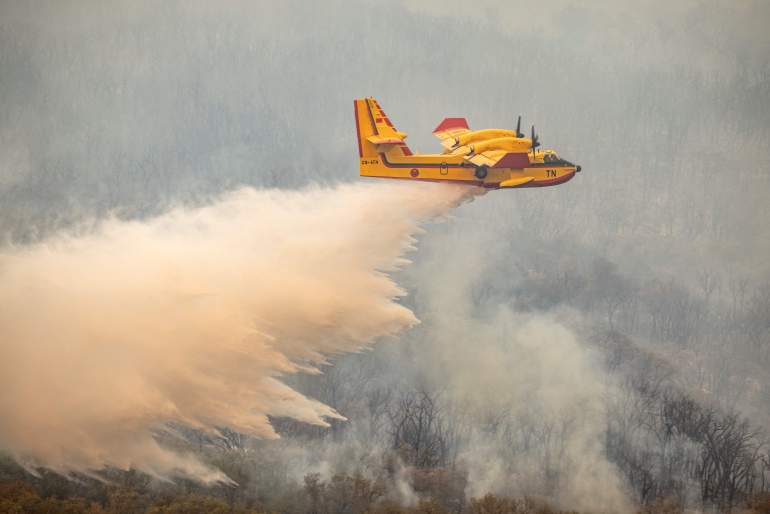Morocco -
“Seeing 5 years of planting and searching for uncommon varieties turn to ashes makes you only come close to understanding the feeling of those who saw the harvest of their lives, livestock, and sustenance wasted,” wrote Khaled Mouden - one of the victims of the fires in the north of Morocco - on his Facebook page.
Part of the residents of Dowair (small rural gatherings), the tribe of Ahl Serif, on the outskirts of Larache, began to return to their homes safely after the flames had been extinguished, while others are still in shelters or with friends and family.
Ashes, smoke and the remains of burnt branches, this is how the scene appears in more than one place, about a week after the fires erupted in 6 spots in northern Morocco at the same time.
The fire killed a person and destroyed more than 9,000 hectares, in addition to losses in farms, livestock and buildings, a heavy toll that is still expected to increase with more heat waves and east winds that accelerate the spread.
Jawad Shahmoud - from the people of water (small rural gatherings) - tells Al Jazeera Net that "the atmosphere was terrible, the fire came at a rapid pace, terrifying people, everyone fled, leaving behind what they owned, surviving with their skins from unprecedented fires."
Jawad and a group of young people from the area closely follow the situation and write on a Facebook forum what happened to them, their families and the residents of the area. They monitor how the people were damaged and some of their entire homes were burned down. They issue distress calls and contribute to documentation, follow-up and monitoring.
Jawad told us about areas that were completely burnt, such as Al-Azeeb, and other areas that sustained losses in livestock and sheep, while the Roundabout of the Water People witnessed, for example, a fire in olive trees that exceeded 10,000 trees, according to the monitoring of the Ahl Serif Forum. Doomed and heavy losses.
Rescue teams are trying to control the fires in northern Morocco (French)
A struggle against time and heat
For his part, the head of the National Center for Climate Risk Management at the National Water and Forest Agency, Fouad Al-Assali, said that the largest fires broke out in the "Al Qila" area, where the affected area amounted to about 7800 hectares in one fire.
The Moroccan official added that about 90% of the fire was cordoned off, and it is expected that today it will be completely controlled, pointing out that there are about 1,200 members of civil protection, the royal gendarmerie and others in the minority trying to extinguish the last outposts and contain the fire once and for all.
Al-Assali believes that Morocco made a good management of resources, which enabled it to control the fires, noting that "six simultaneous fires and what they represent in terms of distraction of effort constituted a great challenge in which the interventionists succeeded, praise be to God."
A warning bulletin from the Directorate General of Meteorology in Morocco stated that a high heat wave is expected to be recorded from today, Tuesday to next Sunday, in a large number of regions of the Kingdom, where temperatures are expected to range between 41 and 46 degrees in the cities and regions of the south, as well as in the northern regions which It is still living on the impact of the danger of the fires that destroyed a large part of the forests in the provinces of Larache, Chefchaouen, Tetouan and Ouazzane.
Al-Asali points out that the factors of climatic changes, the scarcity of precipitation and the rise in temperature increase the height of the fires and are not the direct cause.
The fire broke out on perennial trees and rare plants (French)
Damage to an integrated ecosystem
Concerning the direct damage of the forest fire, the expert in climate and sustainable development, Mohamed bin Abbou, says that the fire means the loss of an ecosystem with all its components and it is difficult to replace, pointing to the loss of perennial trees, rare plants and beehives, and the plant and animal biodiversity that is difficult to compensate.
For his part, Ahmed Ashernan, who is interested in issues of climate and environmental change in the northern region, said that the decline of vegetation cover is one of the indicators of ecosystem imbalance, and part of it is due to fires or attacks on forests.
The civil activist said that some trees, such as cork oak, need at least 40 years to regenerate, noting that the area includes rare and endangered trees such as "Moroccan fir".
In the same context, Fouad Al-Assali said that there are teams working on experiences and lessons learned and working on how to restore and renew the forest.
The local authority had formed committees to carry out social work and listen to the affected population in order to take stock of losses.
On the other hand, opposition parliamentarians and human rights bodies called on the government to activate the natural disaster fund to compensate those who lost their agriculture, livestock and housing, especially in mountainous areas.
It is noteworthy that Morocco witnesses annually a number of forest fires, which cover about 12% of the country's total area.

